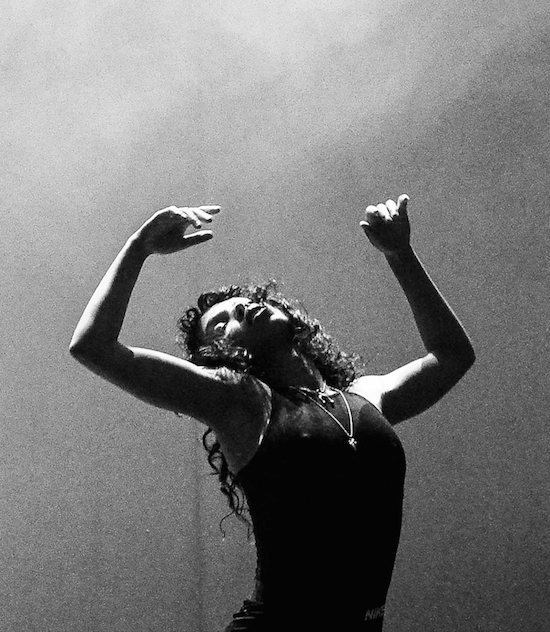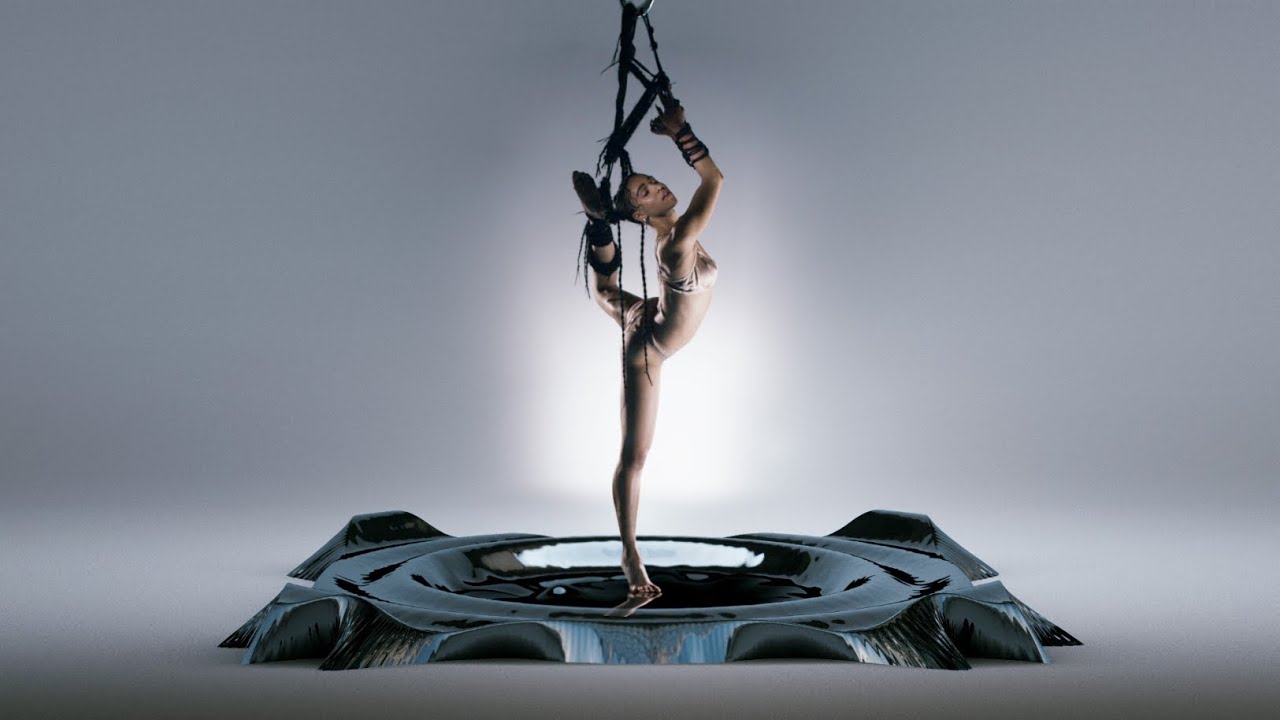Photo by Paula Harrowing
"Dance cannot exist without dance design: the choreography. But dance is the dancer."
-Susan Sontag, Dancer And The Dance
"Just do whatever you think is going to stop it going frizzy." FKA twigs is curled up on a chair in a tiny dressing room at Manchester’s Old Granada Studios, gesticulating towards her hair in the mirror to the two women stood behind her. Our surroundings are soon to become what the showroom on the ground floor describes as a "vertical village" – another glass splinter to puncture the sky that hangs above the city centre – but for the last week have been playing host to twigs and her creative team, as part of a nine day residency hosted by Manchester International Festival. A dance-based series of performances titled Soundtrack 7, she refers now to the experience of putting it together as, "the most fun thing I’ve ever done in my life."
Twigs is already six days into her residency when I arrive at the studios on Quay Street on Wednesday morning. Inside the block her team have taken over for the week, one of the old recording studios has become a temporary green room. Dancers wander in at various points in the day during rehearsal intermissions; bone-breakers casually slinging arms behind their necks, others falling into handstands on the carpet while they wait to be called to stage. Along the back wall a team huddled over MacBooks are working on ‘Inside Soundtrack 7‘; a daily documentation of videos, .gifs and photo sets uploaded onto twigs’ Tumblr page. The production office is situated in the old control room, which looks like it was abandoned during an apocalypse in the 70s. Walls are lined with rounded bulging screens, VHS tapes of old ITV programmes are discarded on the wooden desks, and reels of tape litter the floor. The only signifiers of contemporary existence are a few external hard drives and MIF laminates scattered across the surfaces. At the heart of it all, behind a thick curtain, is a dark smog-filled stage space, where a small group of about twenty people sit in the shadows on painted black benches, waiting expectantly. They’ve been invited here to witness the trials, tribulations, and monotony of the artist at work; over the course of the day they silently file in for thirty minute intervals of voyeurism, as each dance-based performance piece is rehearsed, filmed and modified before them. The whole thing is a lottery: some audiences get thirty arduous minutes of the crew adjusting a light fixture, some get thirty minutes of vicarious exhaustion as a routine is tirelessly reiterated.
The concept of Soundtrack 7, twigs explains to me, came to her about a year ago. "It’s supposed to be a soundtrack of things that I’ve gone through in my life with music that I’ve made in the last few years. Some of the ideas for songs were started up to ten years ago, so it’s kind of like soundtrack of the past ten years of my life told in stories." She insists that they aren’t entirely to be taken at face value though. ‘Mother Creep’, taken from her forthcoming EP M3LL155X, tells the story of a protagonist whose four children are leaving home and beginning to challenge her authority. "I’m an only child so that’s not my story, but it’s the same feeling," twigs says of the song’s themes. Similarly, the track ‘What I Wanna’ by rapper Lucki Eck$ – which in Soundtrack 7 features an added verse from twigs and is played out in a routine of antagonistic krumping and b-boying by a group of male dancers – depicts a man tempted by a lifestyle that he doesn’t really want to partake in: coercion, aggression, drug-taking. "I’ve never been asked to be in a gang, but it doesn’t mean that I haven’t been put in scenarios where I feel tempted by things and I feel frustrated by myself if I give in to a certain way of living my life," twigs explains. "Maybe the story isn’t always the same, but the core emotion is."
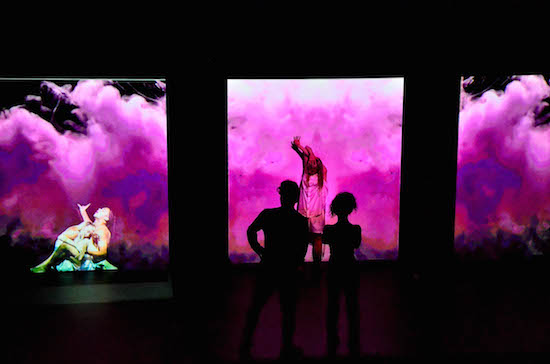
Photo by Paula Harrowing
Since the release of her debut EP in 2012 – four tracks and accompanying videos created with her close friend Grace Ladjoda – FKA twigs has swiftly become one of the most intriguing multidisciplinary pop artists of our generation. Obliterating the notion of the contemporary pop star as a vacant ice tray waiting to be filled with ideas and concepts from the tap of marketability, twigs instead pursues a relentless streak of creative autonomy. Another EP in 2013 and an album released last year have followed this upward trajectory. Her lyrics of female sexual empowerment are accompanied by impressive visuals, including phallic anthuriums, execution chambers and the birthing of endless feet of chiffon in a strobe-lit forest. There’s crossover too: a video commissioned by Google Glass last October subverted the limitations of counter-culture by openly embracing a capitalist concept without compromising her vision for vacant tackiness.
In an age of complacent transiency, twigs’ body of work feels markedly different to anything else currently being created within the peripheries of the mainstream. "When have you ever seen the bottom of Beyoncé or Rihanna’s feet?" she asked in a Q&A with the festival’s organisers earlier in the week. The statement references a closeup of the soles of twigs’ feet in her video for ‘Pendulum’, in which she’s strung up in Shibari bondage, but it also sits as a wider, all-encompassing assertion of her work. This is not only pop music at its most sensual, its most sinister, but at its very most intimate. It’s not hard to see why twigs, an artist for which the creative process is just as pertinent as the performance itself, would want to invite people to witness how it happens.
"I thought it might be a challenge for me to work under that pressure," she explains, as the women behind her begin to canerow her hair from the front. "I wanted to see what that would feel like. I usually work with the same people all the time, and I thought it might be quite a challenge to open that up. It actually hasn’t been – it’s weird – I don’t even notice people coming in now.
"I also thought it would be quite interesting for people really to see what the process is and how hard work it can be, how tedious it can be," she adds. "Sometimes you do an amazing take and the dancing is incredible and the lighting messes up or the camera battery dies halfway through and your heart sinks when you realise you’ve done an incredible take and something’s gone wrong. I just think it’s interesting for people to see that it’s not glamorous. It’s not fun and games and it actually can be tedious at times."
It’s 2pm. Inside the main studio a man scoops synthetic fog higher into the air with a giant piece of cardboard. Twigs’ "dance captain" Denzel Daniels is being misted with oil sprayed from a little bottle by a crew member. The entire studio is completely dark, save for a circular spotlight focused on the centre of the stage. Daniels hunches in the middle, head down, fists held over his face. A voice calls out for playback and the opening rumbles of twig’s ‘Closer’ tumble out from the PA. Daniels begins his dance solo: his head, limbs and body contorting and thrashing with the utmost precision. As his hands mechanically crawl up his own neck, there’s a call to cut and the crew begin the process of setting it all up again.
Watching Daniels is an entirely mesmerising experience. The process of repetition allows you to appreciate moments that you might have missed the first time, or ones that you simply take for granted: the slap of his feet on the floor; the sheen of sweat that clings to his angular body; his expanding and contracting ribcage; the sheer physicality of having to do something meticulously over and over again until its entirely perfect. And then once more still.
"I’m good at knowing when people are better than me at things," twigs admits to me later. "Denzel was showing me some of the moves for ‘Closer’ a couple of weeks ago. I was like: he looks so beautiful doing it, more beautiful than I could ever look – so he should just dance the solo. Although this whole thing comes under the banner of FKA twigs, he’s better at dancing than me so I don’t feel like I have to have the dance solo just because it’s my song and this is the one solo in the whole show. At the end of the day it’s what’s best for the project."
After a couple more run-throughs, there’s a problem with a projection and a subsequent lengthy delay as lighting designer Tobias G. Rylander and the crew rush around to fix it. Daniels takes a seat and a bottle of water. The tedium of witnessing art in progress soon sets in. While the process isn’t always enthralling to watch, nor indeed is it supposed to be, it’s impossible to deny the sheer exertion that goes into putting something like this together.
Back in the dressing room, twigs sidesteps my suggestion that by having an audience present the creative process in itself becomes a form of performance, shrugging it off with a "we just do ourselves", but it’s difficult to escape the notion of this being a weirdly hyperrealist rendering.
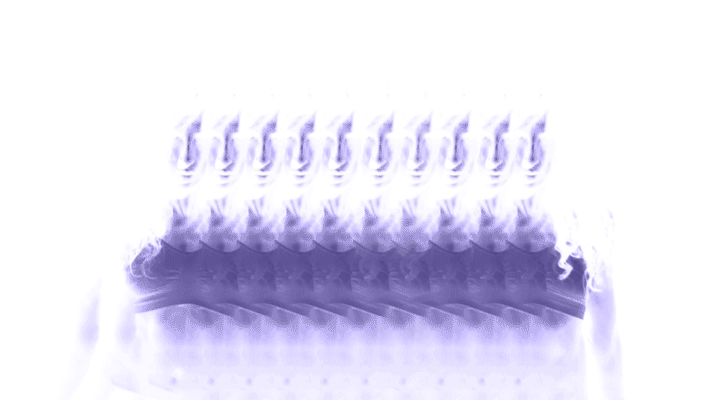
"Guys, stand as you normally would, in a position that feels comfortable to you," choreographer Aaron Sillis calls out from behind a laptop. It’s late afternoon and I’m back on the wooden benches again, watching as twigs and eight other dancers rehearse and film the routine for ‘How’s That’. Each time they’ve completed the track, twigs watches everything back on the monitor, the dancers gathered around her as they intently devour the images on the screen, laughing at parts, gasping and applauding at others. As soon as its played through, she’s back on her feet; directing an alternative run-through for the cameraman, or making suggestions to the dancers: to tilt their heads back a little more, or to look into the camera in a certain way, all while a make up artist blots her forehead and someone fiddles with her hair.
"It’s been a case of character work, rather than worrying whether it’s your left foot or your right foot the day before we shoot," says twigs of the week’s creative process. "Everything’s already been set up in the pre-planning. I’ve done moodboard after moodboard of how the lighting should be, the fill, references, the emotion in the piece, how it has to build, at 1:43 seconds it should go to this. I’ve spent so much time on it that I know exactly what it will be and how it will look. Obviously a few surprises happen along the way."
While twigs directs, someone in the crew runs to refill the dry ice machine and another mops residue off the stage floor.
"I like the idea that sometimes people will come in and I’ll be like exactly how they want me to be," twigs says at one point during our interview. "I’ll be dolled up with a red lip and a leotard throwing my legs and arms around, being tossed about in the air by a big hunky contemporary dancer. Then the next minute the next group come in and I’m in a tracksuit and I’ve got half my makeup down my face because I’ve been sweating and I’m stressing out over one light, or no one’s talking to each other because we’ve all just got stressed with each other and we’re waiting for a new battery to arrive. I liked the idea that one person could get one thing and the next could get something completely different.
"Some people come and they think it’s going to be a performance. They do get explained to very clearly what it is, but you can’t help if people miss that. It’s the complete luck of the draw as to whether I’ll be in there. There could be a group in right now, but I’m sitting here getting ready for my performance and talking to you. That’s the reality of making something, you’re not always in the room."
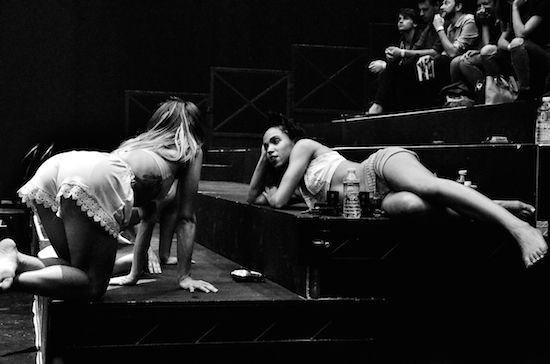
Photo by Paula Harrowing
It’s Friday evening, and in the studios the pitch black void ahead awaits the debut unveiling of Soundtrack 7 in its entirety. The venue is sticky with intimate heat, but there can’t be more than 300 people seated in the darkness.
A drone neatly fades to silence and the chatter slips away. Tonight’s performance begins with twigs reciting the same Thomas Wyatt poem that features on LP1‘s opener ‘Preface’; here it’s enunciated slowly and deliberately. It reappears throughout the performance, threading together the individual pieces, leading dancers to their marks through the darkness, the solemn refrain of "I love another, and thus I hate myself" feeling more marked than it ever has in twigs’ sung falsetto.
While her Congregata performance at London’s Roundhouse earlier this year was hyperbolic in every way, here twigs has diluted the theatrics into a skeletal framework of minimalism. Delicate bursts of smoke replace laser curtains; simple geometrics of light replace rotating floors; practical, neutral costumes replace customised Alexander McQueen. Every detail of the performance consequently becomes an exacerbated focal point, from the flash of a shiny grill, to the blink of a coloured contact lens, to the delicate scrape of a chair leg across the floor. There are more nuanced stylistic differences here too: less voguing (Benjamin Milan is nowhere to be seen); the presence of more women; guttural shrieks and barks that escape from the dancers’ mouths and rise above the music. Where Congregata was chaotic but polished, Soundtrack 7 is animalistic and ravaged. After ‘What I Wanna’, one male dancer’s chest smarts, shining visibly red. Dancers snarl, tongues flashing at the faces peering out at them from the darkness. Masculine and feminine binaries are annihilated: twigs both lifts and is lifted, and everyone switches from dominant to submissive in the stutter of a drum beat. It’s utterly brilliant.
As dry ice spills from behind a curtain and the opening bars of ‘How’s That’ play out for what feels like the thousandth time this week, the final pieces of twigs’ vision slot into place. By now I know nearly every move by heart; from the opening synchronised leaps and fluttering of fingers, to the mechanics of the closing taught human statues and Daniels deftly hoisting twigs into the air. It’s still as impressive as the first time.

